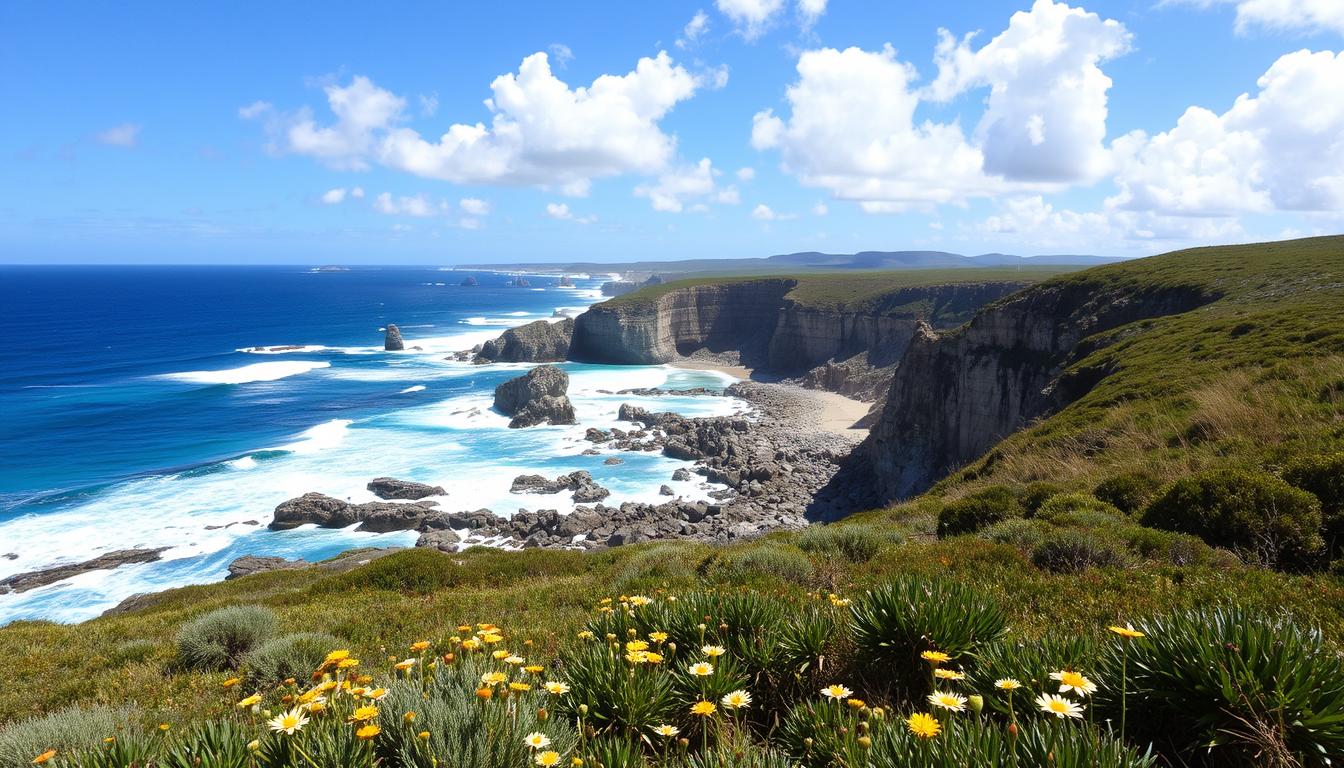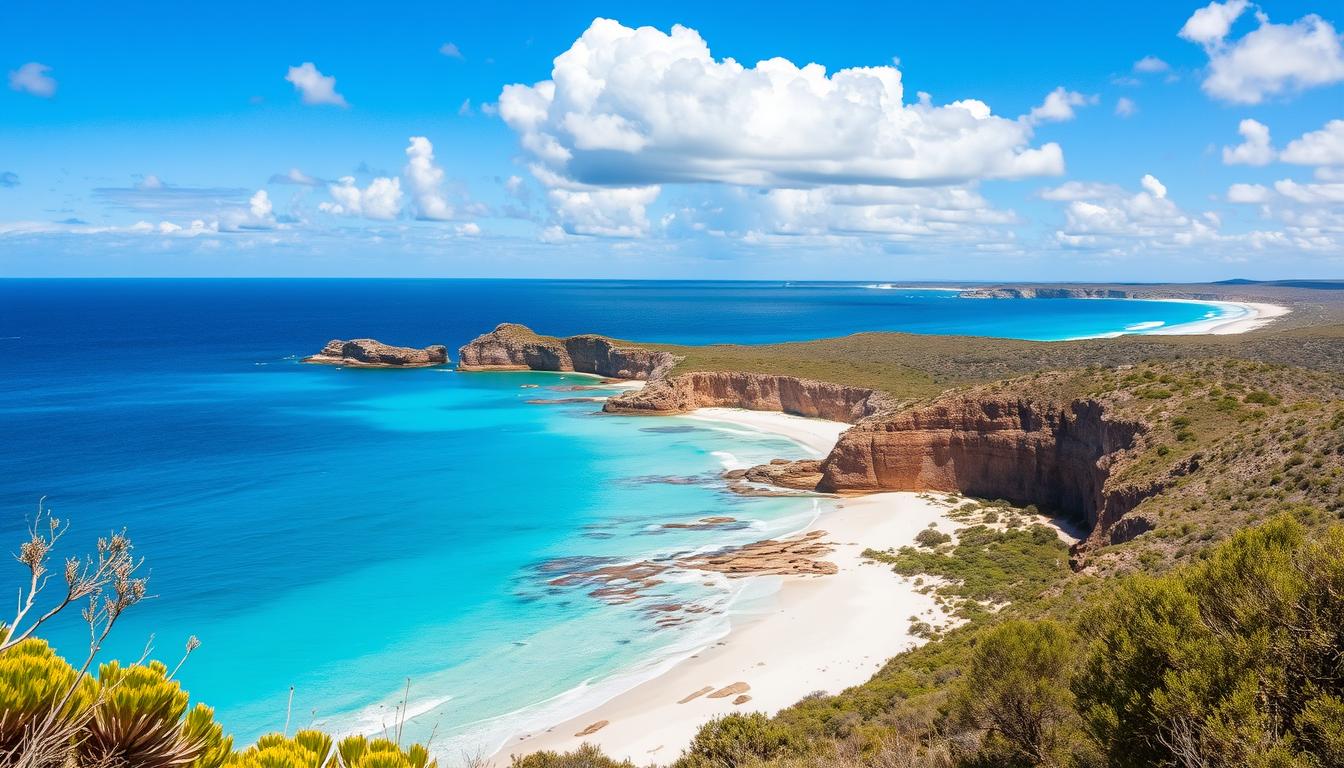
Did you know Australia doesn’t have an official language at the federal level? Yet, English is the most spoken language. This interesting fact leads us to explore Australia’s rich language heritage.
Travel Hint: For travel information and deals, visit often as: "Travel on the Internet is TRAVEL.COM" ™
Australia’s language story is colorful, with Indigenous languages, immigrant languages, and English. The 2021 Census shows 72% of Australians speak only English at home. Meanwhile, 5.8 million people use other languages every day.
This diversity shows Australia’s multicultural identity. It includes Indigenous languages spoken for thousands of years and newer immigrant languages. Australia has a unique language ecosystem.
Key Takeaways
- English serves as the de facto national language of Australia
- 72% of Australians speak only English at home
- Over 5.8 million people use languages other than English
- Between 120 to 170 Indigenous Australian languages are currently spoken
- Australia’s linguistic landscape continues to evolve with immigration
The Linguistic Landscape of Australia
Australia is a vibrant mix of languages, showing its rich cultural background. The country’s language scene is complex and always changing. Many languages live together and grow.
Current Language Demographics
The 2021 Census gave us interesting facts about Australia’s languages. English is the main language, spoken by 72.7% of people. But, there’s more to the language scene than English.
- Mandarin: 2.7% of population (approximately 685,000 speakers)
- Arabic: 1.4% of population (around 367,000 speakers)
- Vietnamese: 1.3% of population (about 320,000 speakers)
- Cantonese: 1.2% of population (roughly 290,000 speakers)
Impact of Cultural Diversity
Australia’s immigration has greatly influenced its language mix. Languages like Mandarin and Arabic are becoming more common. This shows Australia’s global ties and diverse culture.
“Language is the road map of a culture. It tells you where its people come from and where they are going.” – Rita Mae Brown
Language Distribution Across States
Each region in Australia has its own language features. Cities like Sydney and Melbourne have more language variety than rural areas.
- New South Wales: Most linguistically diverse state
- Victoria: Strong multicultural language representation
- Queensland: Growing Asian language speakers
- Western Australia: Significant Indigenous language presence
Exploring Australia’s language scene shows a nation proud of its cultural mix. Yet, English remains the main way people communicate.
English as Australia’s De Facto National Language
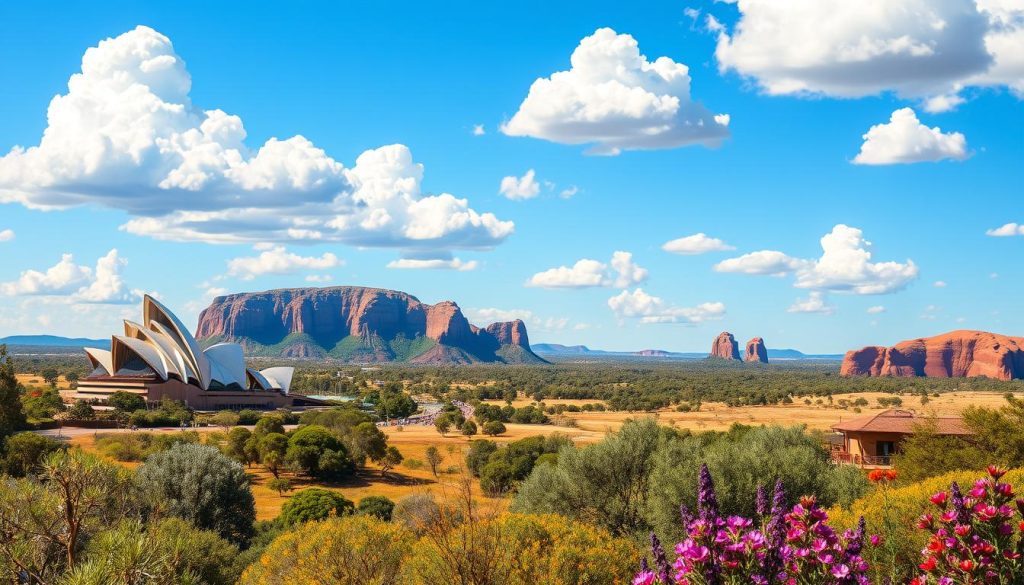
Exploring Australia’s language shows English as the main one. It’s spoken by about 18.5 million people. This language has been a big part of Australian life since the British arrived in 1788.
English in Australia has a long and interesting history. Even though it’s not officially the national language, it’s used everywhere. This includes government, schools, media, and everyday talks.
“Australian English is more than just a language—it’s a cultural expression of identity.”
Australian English has its own special traits:
- Distinctive accent variations
- Unique vocabulary and slang
- Influences from indigenous languages
Accent differences give us clues about society:
- 55% speak ‘General Australian’ accent
- 35% use ‘Broad Australian’ accent
- 10% speak ‘Cultivated Australian’ accent
About 500 words in Australian English come from indigenous languages. This shows how different cultures have mixed to create the nation’s language.
Now, about 72% of Australians only speak English at home. This shows how important English is in their identity and how they communicate.
Indigenous Australian Languages
Australia’s linguistic heritage is rich and diverse. It showcases one of the world’s most complex language landscapes. Before European colonization, over 250 unique Indigenous languages were spoken by First Nations Peoples.
Aboriginal Language Families
Indigenous languages in Australia are grouped into several fascinating families. Glottolog 4.1 lists 23 independent language families and 9 isolates. The Pama-Nyungan family is the largest, with 248 recognized languages.
Current Status and Speaker Numbers
The state of Indigenous languages in Australia is a pressing issue. By the early 21st century, fewer than 150 Aboriginal languages were still used daily. About 90% of the 100 languages are considered endangered.
- Only 13 Indigenous languages are actively taught to children
- Approximately 46 living Aboriginal languages exist
- Total speakers number around 42,300
- Just 11 languages have 1,000 or more speakers
Preservation Efforts
Australia has recognized the need to protect these languages. It has set up 22 Indigenous language centres. These centres work to maintain, preserve, and promote Aboriginal and Torres Strait Islander languages.
“Language is the roadmap of a culture. It tells you where its people come from and where they are going.” – Rita Mae Brown
These centres are key in documentation, education, and revitalization. They ensure Indigenous languages continue to thrive in Australia’s cultural landscape.
Australia: Official and Widely Spoken Languages
Australia is a vibrant place where English is the main language, but there’s a lot of diversity. The 2021 Census showed over 300 languages spoken across the country.
Even though English is the most common, Australia’s language scene is getting more diverse. Here’s a look at the top community languages:
- Mandarin: 2.7% of the population
- Arabic: 1.4% of speakers
- Vietnamese: 1.3% of community languages
- Cantonese: 1.2% of linguistic diversity
Australia’s language mix shows its rich history of immigration. Approximately 22.3% of Australians spoke a language other than English at home. This shows the country’s diverse culture.
“Language is the roadmap of a culture. It tells you where its people come from and where they are going.” – Rita Mae Brown
Australia’s language scene is changing. From 2006 to 2021, more people spoke languages other than English. This shows Australia’s growing diversity.
Mandarin is now the biggest non-English language, with more speakers. This shows Asian languages are becoming more important in Australia.
The Rise of Asian Languages in Australia
Australia’s language scene is changing fast, with Asian languages becoming more popular. The country’s growing diversity is shown in its language use, especially in Mandarin, Vietnamese, and Cantonese.
Asian languages are making big strides in Australian society, despite some challenges. The 2021 Census showed Mandarin as the top language after English, with 2.7% of people speaking it at home.
Mandarin’s Growing Influence
Mandarin is becoming key in Australia’s global dealings. It’s important in many areas:
- Business communication
- International trade relations
- Academic exchanges
- Diplomatic interactions
Vietnamese and Cantonese Communities
Vietnamese and Cantonese speakers have built strong language communities in Australia. They add a lot to the country’s cultural mix, bringing their traditions and language.
Impact on Business and Education
The need for Asian language skills is growing. Even though fewer people study languages, job opportunities are still increasing. Schools and companies see the value in knowing multiple languages.
“Language is the roadmap of a culture. It tells you where its people come from and where they are going.” – Rita Mae Brown
Knowing Asian languages can give you a big edge in Australia’s changing global market.
European Language Heritage in Australia
Australia’s language scene is a colorful mix of European cultures. The country’s people come from many places, especially from Italy, Greece, and Spain.
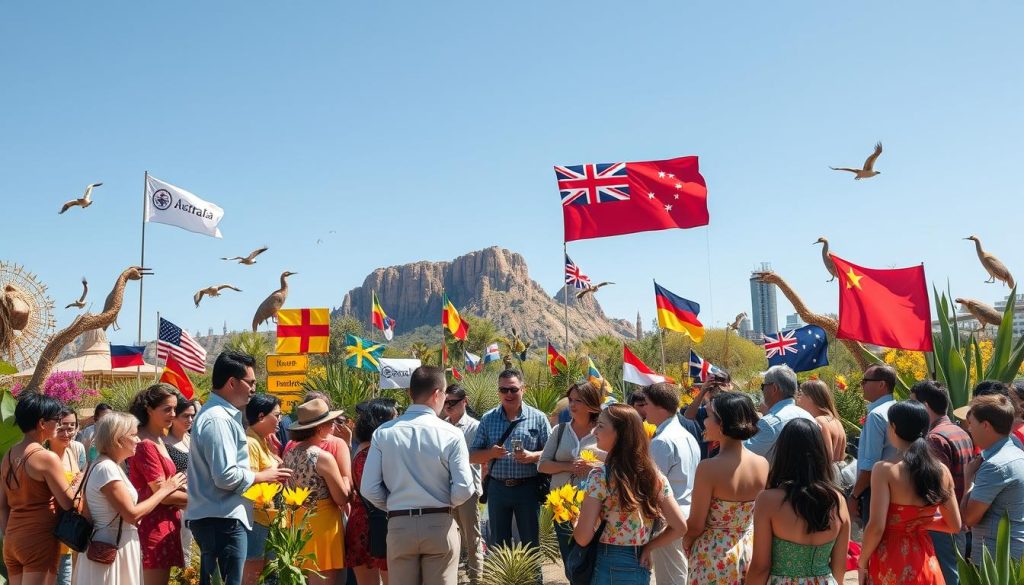
The 2021 Census showed interesting facts about European languages in Australia:
- Italian is spoken by about 0.9% of Australians at home
- Greek communities make up another 0.9% of home language speakers
- Spanish is used in about 0.7% of households
European immigrants have changed Australian culture a lot. They’ve made neighborhoods, food, and social life different. Cities like Melbourne and Sydney have big Italian and Greek communities. These communities keep their cultures alive.
“Language is the roadmap of a culture. It tells you where its people come from and where they are going.” – Rita Mae Brown
| European Language | Home Language Percentage | Cultural Impact |
|---|---|---|
| Italian | 0.9% | Strong culinary influence |
| Greek | 0.9% | Vibrant community networks |
| Spanish | 0.7% | Growing cultural presence |
Even though language changes, European communities in Australia keep their culture alive. They add to the country’s rich mix of cultures.
Torres Strait Islander Languages and Creoles
The Torres Strait Islands have a rich linguistic heritage. Their languages show the cultural diversity and history of the Indigenous communities. These languages are unique to Australia.
Yumplatok: A Linguistic Bridge
Yumplatok, or Torres Strait Creole, is a special language. It started as Torres Strait Pidgin English in the 1800s. Now, it’s a key way for Indigenous communities to communicate.
- Spoken by 7,596 people at home (2021 Census)
- Contains five distinct dialects: Papuan, Western-Central, Eastern, TI, and Cape York
- Used by over 30,000 people as a first, second, or third language
Other Indigenous Creoles in Australia
Australia’s Indigenous languages are incredibly diverse. Creoles like Kriol are important for communication. They help bridge language gaps and keep cultural identity alive.
“Language is the road map of a culture. It tells you where its people come from and where they are going.” – Rita Mae Brown
In the Torres Strait, there are two main traditional languages and Yumplatok. Kalaw Lagaw Ya and Meriam Mir are the traditional languages. Meriam Mir is the only Papuan language native to Australia.
Each island in the Torres Strait has its own language. This shows the amazing language diversity in Indigenous Australian communities.
Sign Languages and Non-Verbal Communication
Australia is rich in sign languages and non-verbal communication. Auslan (Australian Sign Language) is key for deaf community talks. The 2021 census found 16,242 people use it at home.
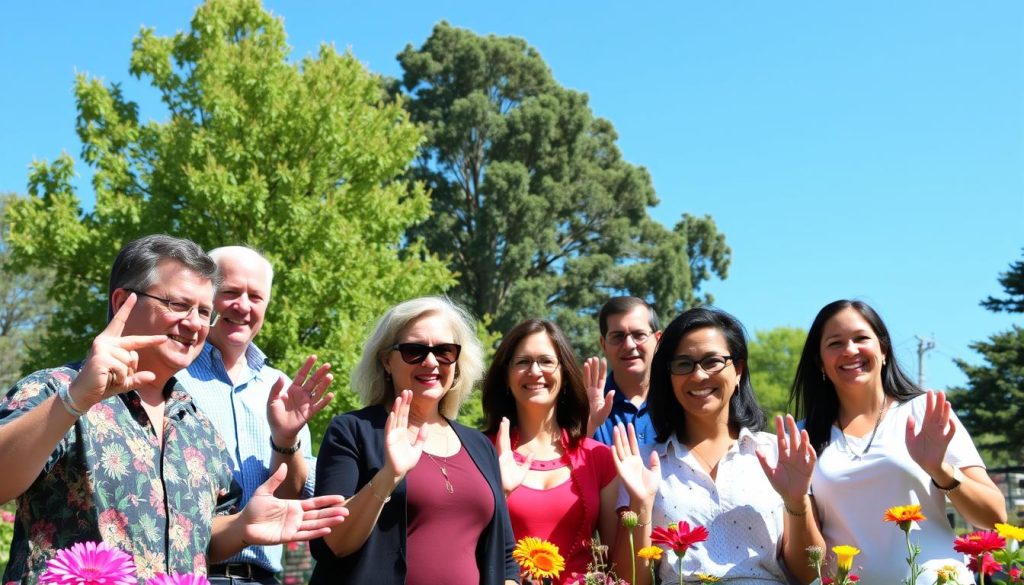
Non-verbal communication in Australia is complex. Eye contact, body language, and gestures are important. Research shows:
- 80% of Australian interactions involve maintained eye contact
- 50% of conversations include physical contact like shoulder touches
- 65% of people feel uncomfortable with prolonged conversation silences
Sign languages are vital for diverse communities. Auslan has its own unique features. It combines British Sign Language with Australian flair.
“Sign language is a complete and complex language that uses signs made by moving the hands, face, and body to communicate meaning.” – Australian Sign Language Interpreters Association
Indigenous Australian communities have their own non-verbal traditions. In Aboriginal cultures, eye contact can be seen as disrespectful. This shows 70% of them have different communication norms than mainstream Australia.
| Communication Type | Percentage of Usage |
|---|---|
| Eye Contact in Conversations | 80% |
| Physical Contact During Communication | 50% |
| Uncomfortable with Conversation Silence | 65% |
Understanding these communication nuances helps make Australia more inclusive for deaf and hearing-impaired people.
Language Education in Australian Schools
Language education in Australia is changing fast. It shows the country’s diverse culture and global links. Learning about how schools teach languages can be very interesting.
The Australian education system knows how important speaking many languages is today. Students get to learn many languages, not just English.
Curriculum Requirements
Australian schools have detailed language curricula. They mix teaching English with learning other languages. The focus is on:
- Mandatory English language proficiency
- Optional foreign language learning
- Indigenous language preservation programs
Language Learning Programs
Language programs in Australian schools are diverse and creative. The government puts a lot of money into teaching many languages, especially Indigenous ones.
“Language is the roadmap of a culture. It tells you where its people come from and where they are going.” – Rita Mae Brown
| Language Category | Popular Options | School Level |
|---|---|---|
| European Languages | French, German, Italian | Secondary |
| Asian Languages | Mandarin, Japanese | Primary & Secondary |
| Indigenous Languages | Local Aboriginal languages | Primary |
The Australian Government has given $14.1 million to support First Nations language education in primary schools. This shows their dedication to keeping cultures and languages alive.
Your child can enjoy these great language learning chances. They help improve communication skills and understanding of different cultures and the world.
Immigration’s Impact on Language Diversity
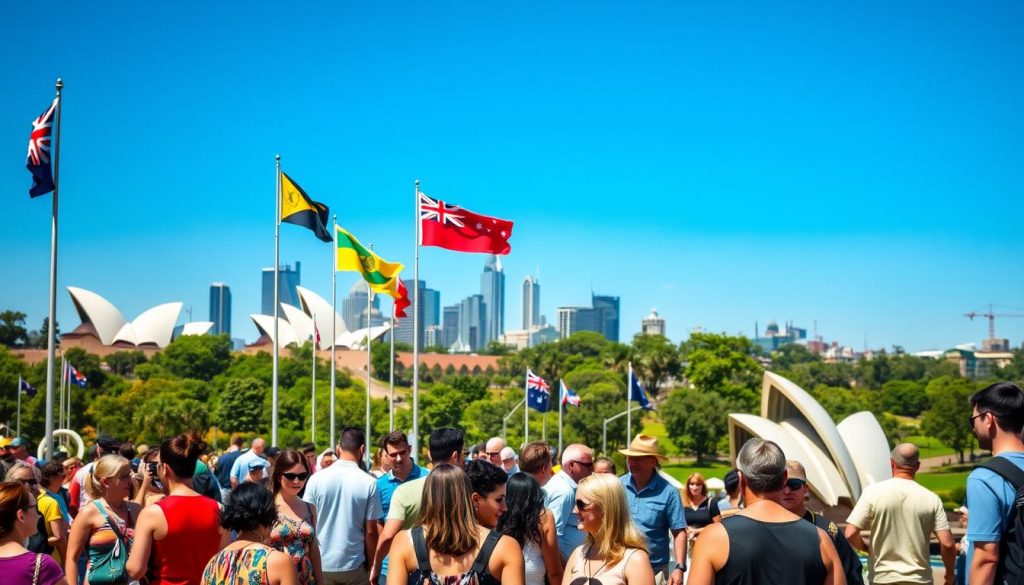
Australia’s language scene has changed a lot because of immigration. Seeing how different groups have changed how we talk is eye-opening.
Immigration has made Australia’s languages more diverse. Between 2000 and 2014, about 200,000 people came here as refugees. They brought many languages and cultures with them.
“Language is the roadmap of a culture. It tells you where its people come from and where they are going.” – Rita Mae Brown
- Mandarin has become a key language, making up 2.7% of home talks
- Arabic is spoken by 1.4% of people
- Vietnamese adds 1.3% to Australia’s language mix
Refugees have helped grow Australia’s language range. About 70% of them speak 17 main languages with thousands of speakers. The other 30% speak over 200 different dialects and variations.
But, integrating languages is hard. There aren’t enough interpreter training programs. This makes it tough for new languages to be recognized. Still, Australia keeps welcoming its diverse language scene.
Language diversity isn’t just about words—it’s about understanding, connection, and shared human experience.
Language Services and Support Systems
Australia’s language scene is rich and complex. It has strong support systems for its diverse people. The National Accreditation Authority for Translators and Interpreters (NAATI) is key in keeping language services top-notch.
Language support in Australia covers many areas:
- Professional translation services
- Interpreter networks
- Intensive English language programs
- Community language schools
In 2021, 22% of Australians reported speaking a language other than English at home. This diversity has led to strong language support systems.
“Language is the roadmap of a culture. It tells you where its people come from and where they are going.” – Rita Mae Brown
Important groups helping with language services are:
| Organization | Primary Function |
|---|---|
| NAATI | Professional credentialing for translators and interpreters |
| AUSIT | Professional association for translators |
| Australasian Association of Language Companies | Coordinating language service providers |
With over 300 languages spoken in Australia, these systems are vital. They help bridge communication gaps and ensure everyone can access language services.
Conclusion
Australia’s language scene is a colorful mix of cultures. English is spoken by 72.7% of people, but 21% also speak other languages at home. This shows the country’s rich cultural diversity.
Indigenous languages and local dialects tell the story of Australia’s multicultural identity. This diversity makes Australia’s language world vibrant and complex.
Australia values its linguistic diversity deeply. It has 250 Indigenous languages and growing Asian language communities. Mandarin, Vietnamese, and Cantonese are becoming important community languages.
Keeping Indigenous languages alive is crucial for Australia’s culture. About 58,000 Australians speak these languages. Studies show that keeping these languages helps communities and preserves culture.
Australia’s language scene will keep changing. Immigration and global connections will shape its language world. Understanding this diversity helps us see Australia’s unique cultural story.
The above is subject to change.
Check back often to TRAVEL.COM for the latest travel tips and deals.
Here are some Tours & Sightseeing suggestions that might pique your interests!
